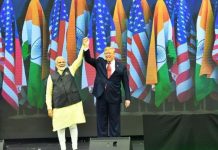
Every time a major international football tournament takes place, football fans burn midnight oil to watch telecast of live matches which generally take place late at night because of the time zone of most football playing nations. There is also a huge following for football clubs like Real Madrid and Chelsea. All this, despite the poor performance of the Indian football team in international arena.
It is now barely among the top 100 teams placed at the 97th rank by FIFA which organises the Football World Cup every four years. About three years ago it had slumped to 173rd position but for a billion strong nation, the 97th position is no consolation. It is in fact a far cry from the glorious days of 1950s and 60s when it was a dominant Asian team and had been participating in Olympics and other international tournaments.
For some it may come as a big surprise that India had actually reached the finals of the 1950 Olympics in football ! This was, albeit, by default. All the other teams in the group figuring India had withdrawn from the Olympics for one reason or the other and the Indian team automatically qualified for the finals. However it too pulled out of Olympics and there is still a controversy on why it did so. The popular belief was that the indian football players lacked proper gear including football shoes. It was also pointed out that they were more comfortable playing barefoot but it was disallowed by the Olympics committee. Others say that Indian government refused financial support to the national team.
But notwithstanding the possibility of a historic Olympics final, the fact remains that the national team notched several honours and won major Asian tournaments during the Golden period of Indian football.
It won the Asian Games gold medal twice — in 1951 and 1962. It was also twice runners-up in the Merdeka football tournament in 1959 and 1964, and in the Asia Cup in 1964. India finished fourth in the 1956 Melbourne Olympics and was the first Asian nation to reach the Olympic football semi-final after defeating several other national teams. India played with distinction in Olympics from 1948 to 1960 when it had qualified for the Olympics for the last time. It has never been able to make it to the World Cup finals and since 1984 it has failed to reach even the Asia Cup final rounds. The last quarter-final appearance by an Indian football team in the Asian Games was in 1982 in Delhi.
Old timers would still recall names of great players during that period. These include Chuni Goswami, Jarnail Singh, P.K. Banerjee, T. Balaram, Sudhir Karmakar, Peter Thangaraj, Altaf Ahmed and Yusuf Khan, Prasun Banerjee and Atanu Bhattacharya. Jarnail Singh even captained the Asian All Stars XI. Besides him three other Indian players, Thangaraj, Altaf Ahmed and Yusuf Khan, figured in the Asian All Masters XI.
But despite their talent and capability, none of them opted to turn professional or play for clubs abroad. They rather preferred secured government and public sector jobs despite getting offers to play for foreign clubs. It was only 1999 that the first Indian player, Baichung Bhutia, opted to play in the professional league in England.
So what went wrong with Indian football after the golden period and despite the continued love for the game in India. Evidently there is a combination of reasons which led to its virtual demise at the international level.
Entry of politicians and bureaucrats was perhaps one of the most important factors which has led to the present sorry state of affairs. In the decades after the independence, political leaders who had little knowledge or interest in the game ‘captured’ important posts in Associations. Their aim was only to gain clout and tour abroad on jaunts ostensibly to attend meetings. Bureaucrats too found it lucrative to meddle in the affairs of national and state associations. It led to nepotism, favouritism, political interference and also to less emphasis on training and nurturing of players. This subsequently led to split in Associations as more such worthies sought to take control. Every state had two or more Associations claiming to represent the state. Instead of the focus on players and the game, these became arenas of political intrigue and conspiracies. For instance even the small Union Territory of Chandigarh had three factions for a long time.
The failure of the government to provide direction to the sport or to restrict involvement of politicians and bureaucrats led to the decay of the sport. It made virtually no effort to nurture young players or hire top foreign coaches to train the Indian team. Similarly the government did not encourage clubs and failed to organise regular national level tournaments despite a heritage going back to 1888 when the Durand Cup football tournament was first introduced by the British at Annandale Grounds in Shimla, the former summer capital of the Raj.
In fact there has been a sharp decline in the number of domestic tournaments. As per records over 125 domestic tournaments were held during the 1960s and 1970s but the number has now come down to less than a hundred. Major tournaments like Federation Cup and the Nehru Cup has to be dropped off and in due to lack of fundings and sponsors
Yet football remains the most popular sport after cricket. It has mass following in states like West Bengal, Kerala, Goa and the north east. Some of the TV channels arranged for FIFA World Cup commentary in Bengali and other regional languages.
The decline in the popularity for football was also in direct proportion to the rise of cricket as the favourite game. Partly it was due to a string of defeats in football and partly the increasingly improved standards and victories in cricket that propelled people to go for cricket. Credit is also due to the professional marketing of cricket. India’s victories over western countries, particularly the UK, were other reasons for cricket gaining popularity.
Despite the existence of popular clubs like Mohan Bagan, Dempo, East Bengal, and Salgaokar etc no serious effort was made to market the game like the transformation brought in by Indian Premier League (IPL) in cricket.
But all is not lost still and the continued passion for Football, as witnessed during international matches despite the absence of India, can be rekindled. In fact some efforts are already underway and have begun to reap dividends.
For instance the establishment of the Chandigarh Football Academy in 2000 by the then Punjab Governor and UT Administrator Gen JFR Jacob, is doing exceedingly well. Over 45 of its students have played at international level and seven of under 19 players in India Team were from the Academy. It selects students from across the country after evaluating their potential and provide free boarding and lodging, schooling and coaching to the selected wards. Many of them are from the north eastern region, West Bengal and Goa. Then there are academies and clubs like Mahilpur Football Club set up by an NRI and Minerva Football Club. Establishment of many more such academies is needed to help restore glory of the game. It would hopefully help in getting crowds back to the stadiums and no future Indian captain shall not have to appeal for attendance at football matches as was done recently by Sunil Chhetri. He recently appealed for more attendance during football matches : “Come to the stadium, do it (criticise) on our face, scream at us, shout at us, abuse us, who knows one day we might change you guys, you might start cheering for us. You guys have no idea how important you guys are and how important your support is,” the skipper appealed.
letters@tehelka.com













